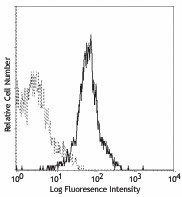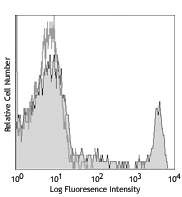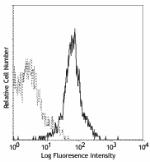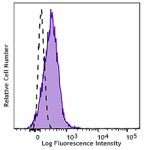- Clone
- MOB-47 (See other available formats)
- Regulatory Status
- RUO
- Other Names
- IFN-γ Receptor β chain, IFN-γ AF-1
- Isotype
- Armenian Hamster IgG
- Ave. Rating
- Submit a Review
- Product Citations
- publications

-

A20 B cell line stained with MOB-47 PE
| Cat # | Size | Price | Quantity Check Availability | Save | ||
|---|---|---|---|---|---|---|
| 113603 | 50 µg | 98€ | ||||
| 113604 | 200 µg | 283€ | ||||
IFN-γ receptor β chain is also known as IFN-γ AF-1. This 60-65 kD class II cytokine receptor pairs with CDw119 to form the IFN-γ receptor. CDw119 serves as the IFN-γ-binding chain and associates with the IFN-γ β chain which is required for receptor signaling. The extracellular portion of both the IFN-γ receptor α and β chains must be species matched. The IFN-γ receptor β chain is expressed at low levels on T and B cells, NK cells, monocytes/ macrophages, and fibroblasts. Binding of IFN-γ induces receptor dimerization, internalization, Jak1 and Jak2 protein kinase activation and, ultimately, STAT1 activation. IFN-γ initiates and regulates a variety of immune responses.
Product DetailsProduct Details
- Verified Reactivity
- Mouse
- Antibody Type
- Monoclonal
- Host Species
- Armenian Hamster
- Immunogen
- Mouse IFN-γR β chain protein
- Formulation
- Phosphate-buffered solution, pH 7.2, containing 0.09% sodium azide.
- Preparation
- The antibody was purified by affinity chromatography, and conjugated with PE under optimal conditions.
- Concentration
- 0.2 mg/ml
- Storage & Handling
- The antibody solution should be stored undiluted between 2°C and 8°C, and protected from prolonged exposure to light. Do not freeze.
- Application
-
FC - Quality tested
- Recommended Usage
-
Each lot of this antibody is quality control tested by immunofluorescent staining with flow cytometric analysis. For flow cytometric staining, the suggested use of this reagent is ≤1.0 µg per million cells in 100 µl volume. It is recommended that the reagent be titrated for optimal performance for each application.
- Excitation Laser
-
Blue Laser (488 nm)
Green Laser (532 nm)/Yellow-Green Laser (561 nm)
- Application Notes
-
Additional reported applications (for the relevant formats) include: Western blotting1 and immunoprecipitation1. For the most successful immunofluorescent staining results, it may be necessary to maximize signal over background by using a relatively bright fluorochrome-antibody conjugate (Cat. No. 113604) or by using a high sensitivity, three-layer staining technique (e.g., including a biotinylated anti-Armenian hamster IgG (Cat. No. 405501) second step, followed by SAv-PE (Cat. No. 405204)).
-
Application References
(PubMed link indicates BioLegend citation) -
- Bach EA, et al. 1995. Science 270:1215.
- Product Citations
-
- RRID
-
AB_313560 (BioLegend Cat. No. 113603)
AB_313561 (BioLegend Cat. No. 113604)
Antigen Details
- Structure
- Class II cytokine receptor family, associates with CDw119, 60-65 kD, AF-1
- Distribution
-
T and B cells, NK cells, monocytes, macrophages, granulocytes, fibroblasts
- Function
- Regulates immune response, upregulates MHC class I expression
- Ligand/Receptor
- IFN-γ
- Cell Type
- B cells, Fibroblasts, Granulocytes, Macrophages, Monocytes, NK cells, T cells
- Biology Area
- Immunology
- Molecular Family
- CD Molecules, Cytokine/Chemokine Receptors
- Antigen References
-
1. Bach EA, et al. 1995. Science 270:1215.
2. Ansel KM, et al. 2003. Nat. Immunol. 4:616. - Gene ID
- 15978 View all products for this Gene ID
- UniProt
- View information about IFN-gamma R beta chain on UniProt.org
Related Pages & Pathways
Pages
Related FAQs
- What type of PE do you use in your conjugates?
- We use R-PE in our conjugates.
Other Formats
View All IFN-γ R β chain Reagents Request Custom Conjugation| Description | Clone | Applications |
|---|---|---|
| PE anti-mouse IFN-γR β chain | MOB-47 | FC |
| APC anti-mouse IFN-γ R β chain | MOB-47 | FC |
Customers Also Purchased


Compare Data Across All Formats
This data display is provided for general comparisons between formats.
Your actual data may vary due to variations in samples, target cells, instruments and their settings, staining conditions, and other factors.
If you need assistance with selecting the best format contact our expert technical support team.
-
PE anti-mouse IFN-γR β chain

A20 B cell line stained with MOB-47 PE -
APC anti-mouse IFN-γ R β chain

Murine lymphoma cell line A20 was stained with IFN-γR β chai...
 Login / Register
Login / Register 














Follow Us